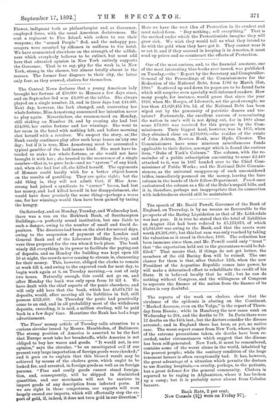One of the most curious, and, to the financial amateur,
one of the most interesting blue-books ever issued, was published on Tuesday,—the Report by the Secretary and Comptroller. General of the Proceedings of the Commissioners for the Reduction of the National Debt, from 1786 to March 31st, 1890." Scattered up and down its pages are to be found facts which will surprise even specially well-informed readers. How many people, for instance, would guess that since the year 1810, when Mr. Burgis, of Isleworth, set the good example, no less than £1,020,455 10s. id. of the National Debt has been wiped out by the generosity of patriotic donors and tes- tators? Fortunately, the excellent custom of remembering the nation in one's will is not dying out, for in 1890 alone some £70,000 was received for this purpose by the Com- missioners. Their biggest haul, however, was in 1855, when they obtained close on 2200,000,—the residue of the estate of John Ashton, Newton Bank, near Hyde, Chester. The Commissioners have some nineteen miscellaneous funds applicable to their duties, amongst which is found the curious item, "Duke of York's Column." The column, with the re- mainder of a public subscription amounting to some £2,440 attached to it, was in 1887 handed over to the Chief Com- missioner of Public Works ; and the National Debt Commis- sioners, as the universal snappers-up of such unconsidered trifles, immediately pounced on the money, leaving the bare column in the hands of their fellow-Department. Punch once caricatured the column as a file of the Duke's unpaid bills, and it is, therefore, perhaps not inappropriate that its connection with indebtedness should still be maintained.


































 Previous page
Previous page